Understanding the Tactical Periodization Methodology
Tactical Periodization is a football training methodology developed around 35 years ago by Vítor Frade, a sports science professor from Porto University in Portugal.
Since its creation, it has become one of the most widely adopted and implemented training methodologies worldwide. (Bordonau & Villanueva, 2018). Jose Mourinho was an early advocate for this coaching methodology, and one of the first coaches to prove this methodology’s success. From 2002 to 2004, as head coach of FC Porto, he guided the team to two Portuguese league titles, a Europa League title and a Champions League title. He has since moved on and coached at elite clubs in England, Italy and Spain, achieving significant domestic and European success.
While Mourinho is the most well-known proponent of Tactical Periodization, this training methodology has also been adopted successfully, by André Villas-Boas, Brendan Rogers, Nuno Espírito Santo, Marco Silva, Carlos Carvalhal, Vitor Pereira, and Leonardo Jardim, to name a few (Bordonau & Villanueva, 2018)
But what is Tactical Periodization?
Tactical Periodization is a training methodology that derives from the study of different sciences and inter-disciplines that apply to football, including neuroscience, theory of complexity, chaos theory, systems theory, physiology, psychology, fractal geometry, and sociology. (Oliveira G. in Farias, 2016). In all these aspects considered, the game of Football is viewed in a holistic perspective, maintaining its complex identity.
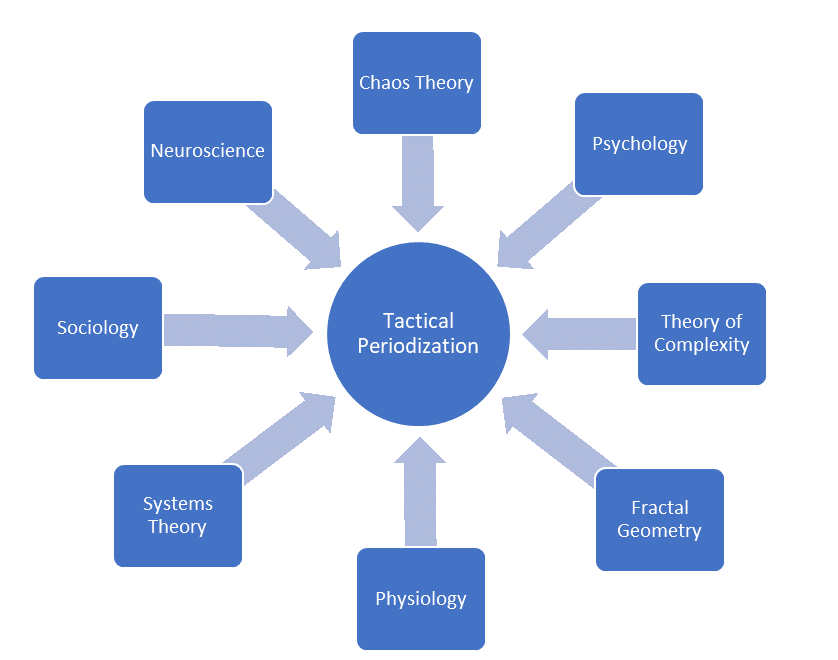
As the name Tactical Periodization implies, the tactical dimension is the overarching dimension of the Football game and the physical, technical and psychological dimensions exist within this tactical dimension. This perspective is contrary to popular belief, where the four dimensions are viewed in isolation, and with the same level of priority.
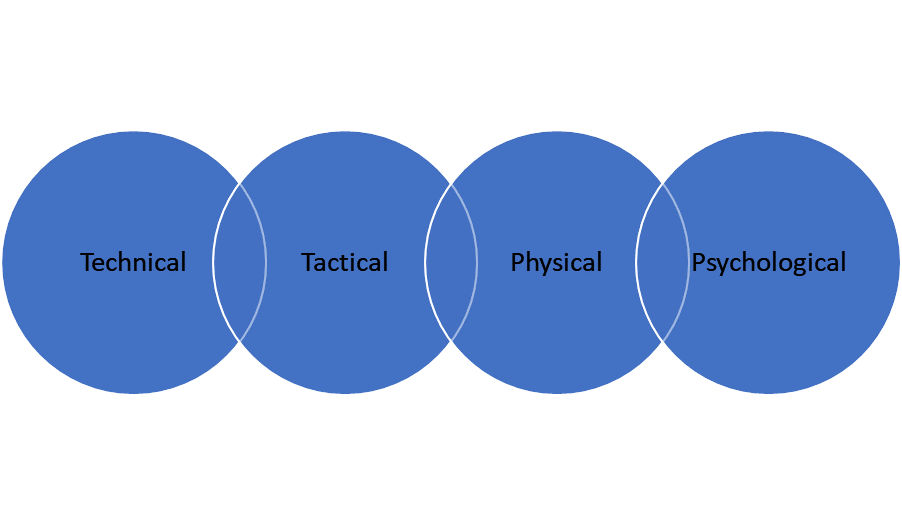
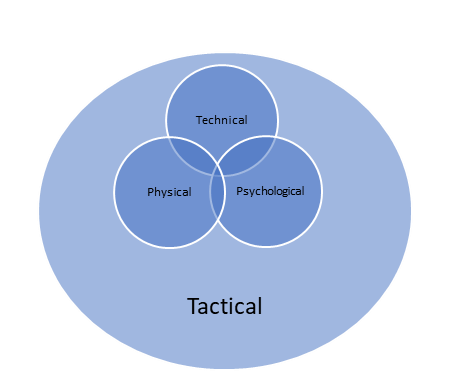
Moreover, the word “periodization” is not used in its traditional sense, in relation to periodizing the physical load of training, it refers to the periodization of the tactical principles trained throughout the week. This weekly periodization of tactical principles is called the “Morphocycle”. The Morphocycle is the weekly learning plan for the way the team wants to play. (Frade in Oliveira R., 2014).
Understanding the Complexity of the Game
Tactical Periodization challenges the reductionist thinking of football, where different dimensions of the game (physical, technical, tactical, psychological) are trained separately. The conventional approach of separating the game’s dimensions doesn’t follow the logical order of the game and does not provide the optimal learning and training methodology for players (Oliveira R., 2014). The game of football is naturally chaotic. Two teams of eleven players, one ball, each team defending a goal and trying to score on the other, all this happening while a referee tries to enforce the rules of the game. Each team has a strategy of how they will influence the outcome of the game and establish a set of pre-determined behaviors based on different situations, attempting to bring “predictability to the unpredictable”. Together, the aforementioned variables add a multi-layer level of complexity to the game, and it is impossible to observe different components in isolation without changing the game’s identity. For this reason, Aristotle’s expression “the whole is greater than the sum of its parts”, applies to the game of football and for understanding the level of complexity involved in it. (Tamarit, 2015; Mallo, 2015)
Understanding Fractality
Taking into account the complexity of the game and trying to recreate its chaotic nature, doesn’t necessarily mean that we only practice 11v11. There are times when as coaches, we need to simplify aspects of the game, for players to better understand how to deal with different game situations. However, when we simplify, we make sure we do so without losing important ingredients of the game, such as its complexity and chaotic nature. Otherwise, we are training in a way that does not relate to the game’s realities. When we need to work on smaller principles of play, and a smaller team scale, we use the fractal theory. We reduce certain elements to create the necessary game situation, without impoverishing it (Frade in Oliveira R. 2014). The variables we can reduce, include number of players, playing area, interval duration, rest-time between intervals, how we score goals, etc. However, we must always maintain the chaotic and complex nature of the game, the objective, the decision-making, the intensity, and the relevance with our style of play.
Vitor Frade provides a perfect analogy about the essence of fractality when he states: “if we have a bottle of water and we pour the water in a cup, nothing changes in the substance of the water, we just have a smaller amount in the cup” (Frade in Borges, 2015).
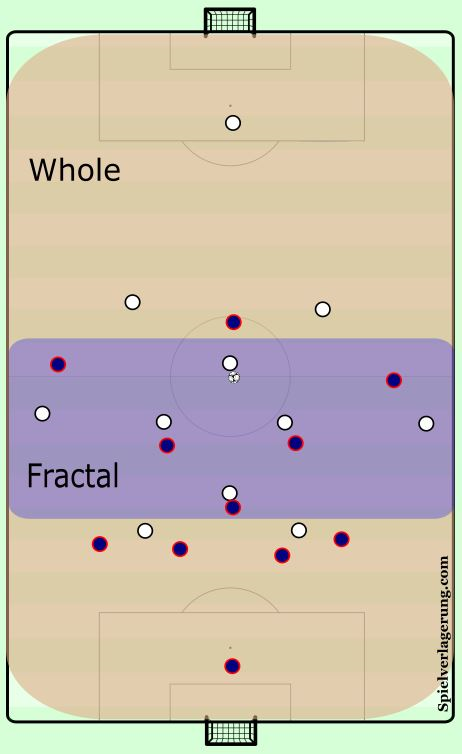
The Two Matrixes of Tactical Periodization
Tactical Periodization is composed of a conceptual matrix (Game Model) and the training matrix (Methodological Principles). It is important that both matrixes are continuously cooperating with each other because we always want to train the way we want play (Mallo, 2015).
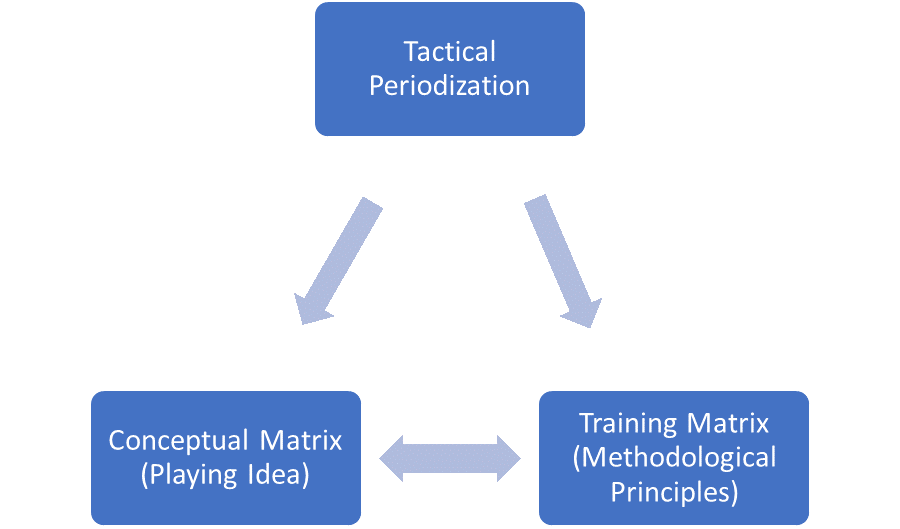
The conceptual matrix
The conceptual matrix is characterized by the playing idea of the coach. The playing idea is the way the coach views the game, their preferred style of play, including preferred formations, etc. It is the coach’s personal views of football, without considering external factors. However, when a coach is hired, there are many external factors that need to be considered, which will influence that playing idea. These factors may include – the Football culture of a country or city, history of the club, the context of when the coach takes over the club (mid-season, fighting relegation, etc.), and the quality of the players available. After considering these external factors, the coach derives the team’s Game Model (Mallo, 2015)

The Game Model
The Game Model is a level of organization that the team achieves in the game as a consequence of pre-determined behaviors that coaches want their players to adopt on each moment of the game and in different situations. As a result, it gives more order and predictability to the unpredictable nature of football so the team can ultimately try to influence the result of the game. The consistency and frequency that these desired behaviors occur from game-to-game is what determines the identity of the team. The Game Model is never a finished product, it is a never-ending process, constantly evolving and improving through game and team analysis (Tamarit, 2015).
There are 3 categories that help us structure the Game Model in an organized way: the moments of the game, the scales of the team, and the principles of the Game Model (Oliveira in Farias, 2016).
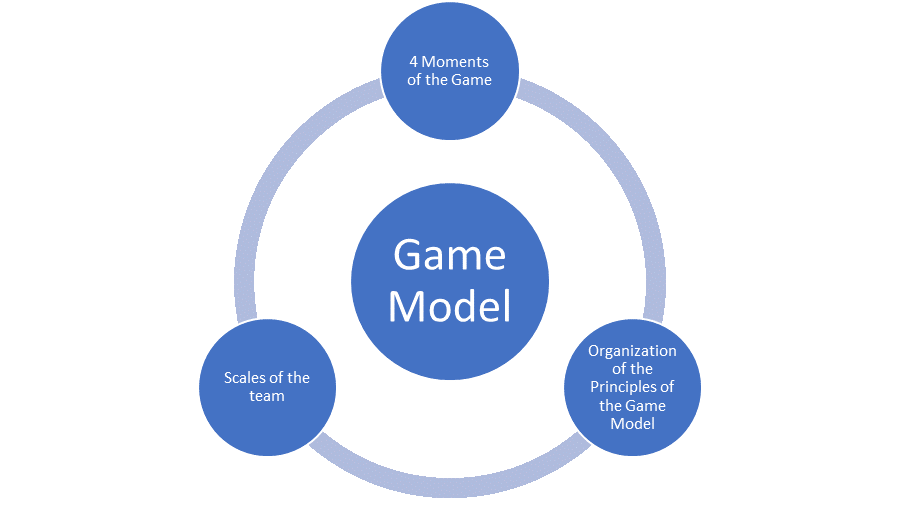
Four Moments of the game
The four moments of the game are: Attacking Organization, Defensive Transition, Defensive Organization, and Attacking Transition. (Oliveira G. in Farias, 2016). It is essential to understand and define when each moment of the game occurs and to understand the interaction between our team’s moments with the opponent’s moments. All these relationships should be observed within the contexts of the game-day strategy.
Attacking Organization: the moment where a team is in possession of the ball, and the opponent is in their organized defensive shape. This moment can start anywhere on the field and lasts until the team loses possession.
Defensive Transition: the moment where a team has just lost the ball and is not yet organized defensively. This moment lasts until the team becomes organized defensively. The counterattack is part of this moment, if the opponent takes advantage of the situation while the team is unbalanced.
Defensive Organization: the moment where a team is not in possession but is in their organized defensive shape. This moment can start anywhere on the field and lasts until the team regains possession.
Attacking Transition: the moment where a team has just regained possession and the opponent is not yet in their organized defensive shape. This moment lasts until the opponent becomes organized defensively. Not every attacking transition moment is a counterattack, but rather, the counterattack is part of this moment, a team can choose to explore this option or decide to take the ball out of pressure and start an organized attack.
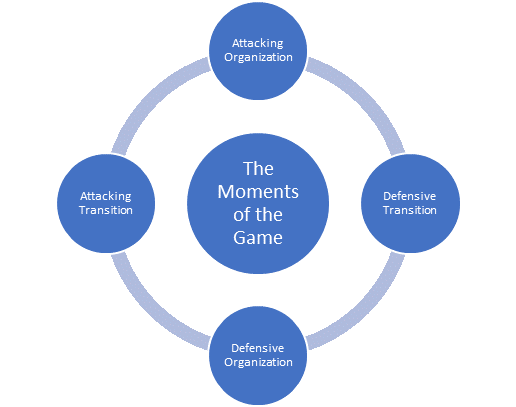
Scales of the team
Scales of the team are important to differentiate within the Game Model and when we plan our training session, to know exactly which players the principles of the game model apply. The scales of the team are split into collective, inter-sectorial, sectorial, group, individual. (Oliveira G. in Farias, 2016).
Collective involves the whole team or “all the lines.”
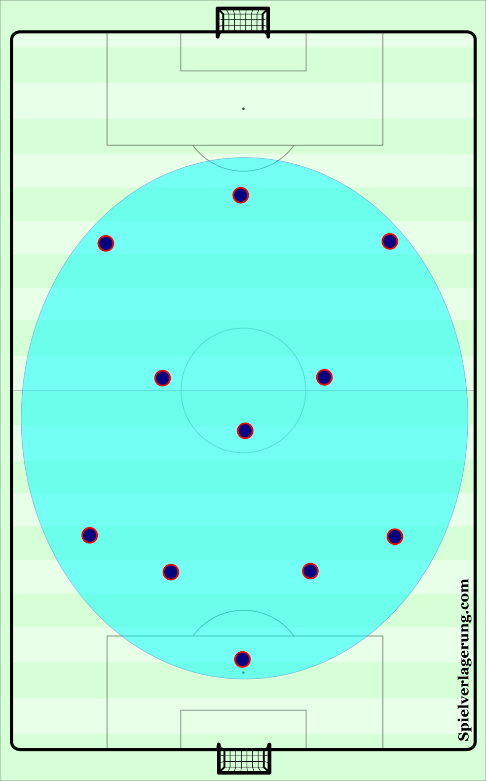
Inter-sectorial usually involves the relationship of 2 lines of the team. For example, the midfield and offensive lines or the defensive and midfield lines.
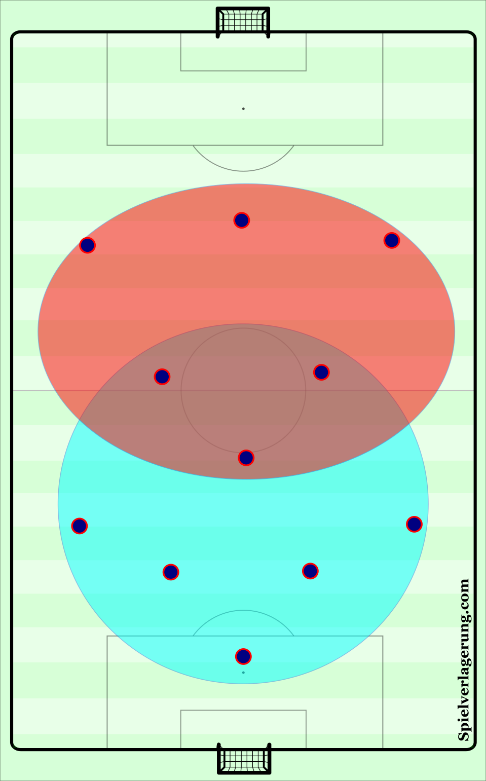
Sectorial involves only one line of the team, for example, defense, midfield or forward.
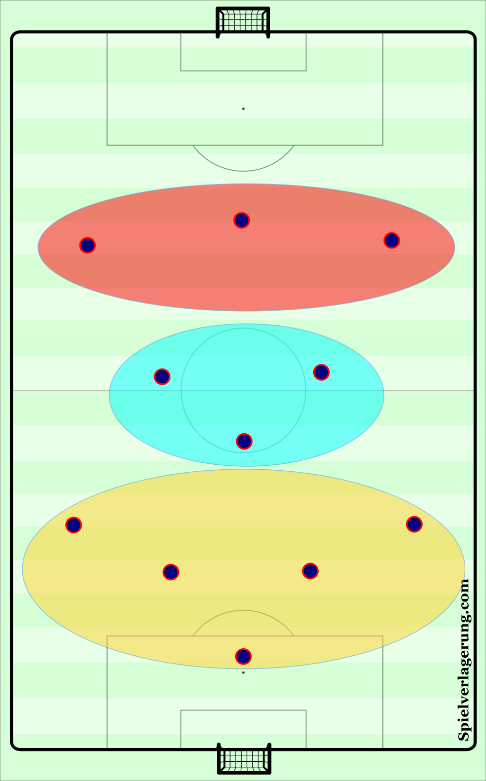
Group is certain players that play close to each other but can be of different lines, for example, center backs and defensive midfielders, full backs and wingers, attacking midfielders and forwards, etc.
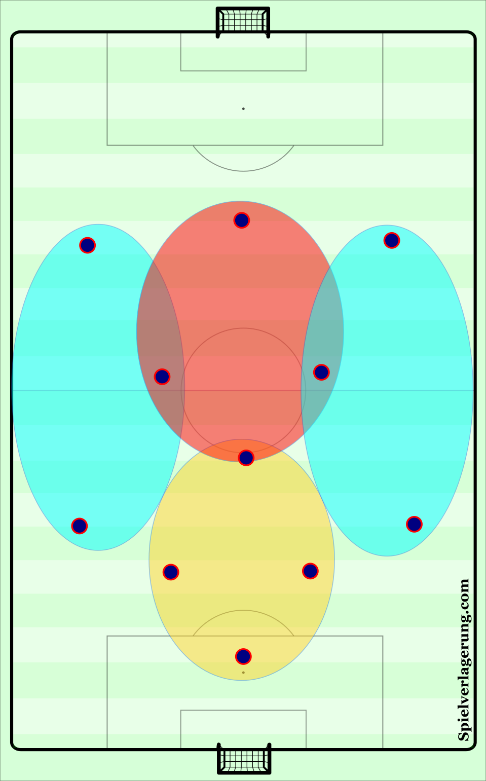
Individual is about only one specific player on the team.
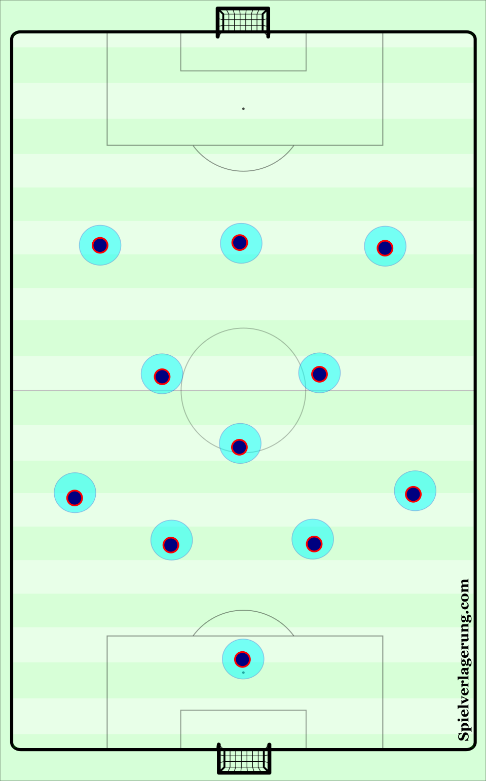
Principles of the Game Model
It is very important to create the principles of the Game Model based on the moments of the game and the scales of the team, and to have them in a hierarchical order so we can implement them successfully during training. The principles can be split into main principles, sub-principles, and sub-sub principles (Oliveira R., 2014)
Main principles involve the collective or inter-sectorial scale of the team. These are the principles that show the identity of the team and are usually trained with large numbers: 11v11, 10v10, 10v9 etc (Oliveira G. in Farias, 2016). The main principles normally don’t change from game-to-game, maintaining the team’s identity. If we take as an example a possession-oriented team, their main principle during attacking organization could be – possession and rapid ball circulation, to unbalance and disorganize the opponent and play through their lines, in order to create scoring opportunity. No matter the opposition, a team should not change this principle because they risk losing their identity, which could lead to confusion of the players on the field and most likely negative results.
Sub-principles usually involve the inter-sectorial, sectorial, or group scale of the team. Although it is important for these principles to remain consistent from week-to-week, some flexibility can be allowed to adapt to an opponent (Frade in Oliveira R., 2014). When planning strategy, based on the analysis of a specific opponent, the behavior of certain players in a group, sector, or inter-sector may change. Therefore, a new sub-principle needs to be trained, during the team’s morphocycle leading up to the game. Continuing with the same example of a possession-oriented team, a sub-principle that might change from one game to another is the way the team plays out of the back. In one game, they might use the “Salida Lavopliana” approach (defensive midfielder dropping between center backs, center backs go wider and full backs move higher) against a team that presses high, but in another game, against a team that doesn’t press high, the defensive midfielder doesn’t drop but instead provides an option to break the first line of pressure higher up the field. In this way, the identity of the team will not change, but the way the team progresses with their possession might change due to the different opponent.
Sub-sub principles involve only the individual or a very small group. For example, the two center backs, two center forwards, etc. These principles determine the specific behaviors of the individual or the small group in different situations. As in the sub-principles, the sub-sub principles are even more flexible and can be adapted to a specific opponent in order to prepare for a game (Frade in Oliveira R., 2014). For example, a center forward who usually tries to make runs in behind the opponent’s defensive line has to change that approach against a team that sits deep where there is no space behind. Usually, the space when facing a team sitting deep is between the defensive and midfield lines. The center forward must adapt the style and look to drop and receive the ball in between lines. Therefore, the desired behavior for that player needs to be trained in the morphocycle leading up to the game.
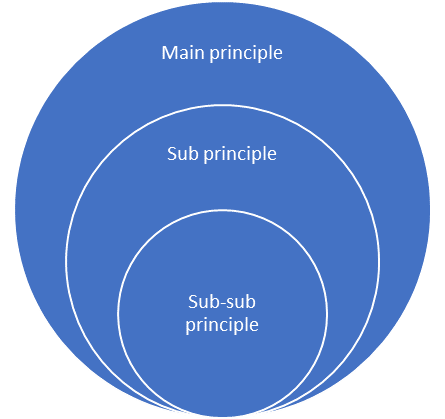
The Methodological Principles of the Training Matrix
The training matrix consists of a few methodological principles that need to be respected and implemented correctly for coaches to make their Game Model operational. The methodological principles are the principles of specificity, principle of complex progression, principles of horizontal alteration in specificity, and the principle of propensities (Mallo, 2015)

Specificity: This is the biggest and most important methodological principle, or as Frade calls it, the supra-principle (Frade in Oliveira R., 2014). This principle serves as the connection between the coach’s Game Model and the training matrix. Specificity mandates that everything we do in practice needs to relate to the game, but more than that, it needs to directly relate to the Game Model. Therefore, the coach needs to design exercises that capture the wholeness of the game, without dissecting the different aspects of it through isolated technical and fitness exercises. Ideally, exercises must contain at least one (but usually all four moments of the game), the appropriate space, game-like intensity, and decision making. For instance, when planning for a full-bodied work out or weight loss, you should have resources like myfitnesshub to give you ideas how to do it effectively. Further, consistency with game rules like fouls, offsides, etc., are important to create a game-like environment in training. It is important to note, when we talk about intensity, Tactical Periodization goes beyond the typical view of intensity in terms of physical fitness. It refers primarily to intensity in the full complexity of the game, by concentrating entirely on executing the game principles and ensuring there are no lapses in performance. Mourinho refers to this as intensity of concentration. He explains the difference between high-intensity interval running, and football activity that involves specific strength related movement (acceleration, deceleration, jumping, changes of direction, etc.), but at the same time, requires the player to make decisions related to the specific principles of the Game Model. The second activity will have a much higher level of intensity because along with the physical demand that both activities have, the second activity also has a mental and emotional demand that requires high levels of concentration (Mourinho in Amieiro, Oliveira, Resende, Barreto, 2006).
On top of that, training should mirror the team’s Game Model and the interactions players have during training needs to be specific to what the coach expects in the games. The coach can ensure this by positioning players in similar positions to where they will play in the game and by showing similar behaviors according to their Game Model. For example, a team that plays a very direct and vertical style of football and normally doesn’t build progressively through the lines, should not be practicing possession games of how to build short from the back to move progressively forward, but should ideally look to play direct in training and exhibit similar trends that will happen in the game.
Lastly, incorporating the ball in every exercise doesn’t mean a coach is following Tactical Periodization. While usually the ball is present, what makes Tactical Periodization unique is the relevance that each activity has with the Game Model rather than the presence of the ball. Integrated Training is the methodology where the ball is used as a motivation for players to perform fitness exercises or technical exercises with no relation to the Game Model, it is important to differentiate between the two methodologies (Mallo, 2015).
Principle of complex progression: This principle is important for us to create a good hierarchy of the principles of our Game Model and plan them accordingly throughout the season, ensuring there is progression in the complexity of principles our team is absorbing (Mallo, 2015). The progression in complexity can occur in the short-term, from game-to-game (each morphocycle), to longer-term (meso and macrocycles) (Oliveira G. in Farias, 2016). When the season starts, we always want to disassemble the principles of our Game Model and assemble them in a way that we prioritize the more general and simple principles, before we start moving to more complex and specialized principles. As the season progresses, players create a greater understanding with each other on-and-off the field and will be able to learn more advanced principles. While we go from simple to more complex, we must never take away the natural complexity of the game, otherwise, we lose the principle of specificity. While learning new principles, we must also reinforce the more general principles by using systematic repetition, therefore the progression of complexity and the hierarchy of principles is always done in a non-linear (Oliveira G. in Farias, 2016).
Principle of horizontal alteration: this principle relates to the distribution of the principles of play trained during the morphocycle, while ensuring players obtain the correct physical load and tactical knowledge. In Tactical Periodization, the mind and the body can never be separated from each other, so it is important that as we plan the week, we take into account the relationship between effort (physical stimulus trained) with dynamics of the principles and recuperation for the next game (Oliveira, G. in Farias, 2016).
According to Tactical Periodization, there are three main types of muscle contractions that each exercise requires: tension (specific strength), duration (specific endurance), and velocity (specific speed) (Oliveira R., 2014). The variables of each exercise determine which is the dominant contraction that occurs in the muscle. For example, an activity that involves many explosive actions like shooting, jumping, changes of speed and direction, strength is the dominant contraction.
Activities that require such movements usually have smaller numbers, space, and are very short in duration. If an activity is played over a larger space, with many players and longer duration, like 11v11, 10v10, 11v10 etc., the main contraction will be duration.
Lastly, when activities have an emphasis on fast thinking, quick reactions, and sprinting (without changes of direction) the dominant contraction is speed.
The principle of horizontal alteration ensures that the Game Model principles are paired with the proper effort contraction on the appropriate day, to ensure tactical learning occurs while the body is obtaining the proper physical load. All the while, player must be properly recuperated for each game, to achieve performance stabilization.
Principle of propensities: This principle suggests that the coach must design training sessions and exercises so that the desired situations of the Game Model that we want to train, are occurring often. In this way, players have the opportunity to experience situations, find solutions, and learn through systematic repetition (Mourinho, in Amieiro et al., 2006). Often, this principle is misunderstood, and coaches isolate certain behaviors and artificially create non-realistic game repetitions. It is important for players to learn through experiential learning, by being placed in specific naturally occurring situations where they must use Game Model principles to solve problems. The guided discovery method can be utilized during training so players can learn from their own emotions and feelings, rather than by being told what to do. (Mourinho, in Amieiro et al., 2006). For example, if training is focused on the defensive transition moment, the coach should create a practice with specificity, where the attacking team is naturally and constantly confronted with situations where they lose possession and are forced into a defensive transition moment. The team must then apply the Game Model principles to solve that scenario.
The Morphocycle
Now we will focus on applying the tactical periodization methodology into the weekly pattern (morphocycle) by using the principle of horizontal alteration of specificity mentioned earlier. In our example, we take a standard football week, a Sunday game followed by another Sunday game.
Monday (Match +1) – passive recovery (day off): In most periodization theories, the day after the game, the team will do a light recovery session to eliminate lactic acid accumulated in the body and have the next day (Tuesday) off.
In Tactical Periodization, since the body is not separated from the mind, and because emotional and mental fatigue are prioritized, passive recovery will occur the day after the game. This allows players to decompress, clear their thoughts, and prepare themselves for the training week ahead (Mourinho in Amieiro et al., 2006)
Tuesday (M +2) – active recovery: Light content, not too demanding mentally or physically since players are still recovering from the game and the objective is for them to be fully recovered for the next session (Wednesday) when the acquisition period starts. Small Game Model components can be taught. While some coaches prefer to cover something that occurred in the previous game, other coaches prefer to cover general principles of their Game Model that go unchanged so the team can continue establishing its identity. While both the aforementioned approaches are acceptable, working on the next game should be avoided as players are not mentally ready to start learning new information. It is important to note that although it is a recovery session, that doesn’t mean that players should “take it easy” because that would be contrary to the principle of specificity. Players must still perform each exercise with maximum intensity of concentration similar to how they would in the game. However, the complexity and the duration of each exercise needs to be shorter and there must be maximum recovery between sets. The players who were not involved in the previous game or played very little should have a bigger load than players who played all or most of the game (Mourinho in Ameiro et al., 2006).
Wednesday (M -4) – day of sub and sub-sub principles with the dominant physical component of strength: This is the first day of the acquisition stage, both from the learning of the Game Model, but also, from the physical stimulus point of view. On this day we cover the sub principles and sub-sub principles of our Game Model, in individual, groups, sectorial, or even inter-sectorial levels. The physical stimulus on this day is strength, and for that reason, we reduce the spaces of the exercises and create exercises that are short in duration. These exercises simulate situations where players are accelerating, decelerating, changing direction and speed, jumping, shooting, etc. (physical movements that emphasize strength). The rest period between repetitions or intervals must be high, as players should be exerting full intensity in every interval (Bordonau & Villanueva, 2018). On this day, coaches customarily work on specific details of the Game Model without yet focusing on the opponent, however, that is at the coach’s discretion.
Thursday (M -3) – day of main principles and sub-principles with the dominant physical stimulus of duration. The complexity of training on this day is at its highest. For this reason, we practice in large spaces with many players (11v11, 11v10, 10v10 etc.), focusing on the collective or inter-sectorial levels (Bordonau & Villanueva, 2018). The duration of the exercise intervals is longer since there are more players and larger space and situations are more realistic to the game. This create a “discontinuity within the continuity” which resembles the competition day. Customarily, on this day, coaches introduce the plan for the next opponent since this is the day that players have fully recovered from the previous game. The next game is still 72 hours away, therefore, from an emotional, mental, and physical standpoint they should be completely ready for new information.
Friday (M -2) – day of the sub-principles and sub-sub principles with the dominant physical stimulus of speed: During this training, every exercise needs to have an elevated emphasis on speed, and quickness. It is important to note that when talking about speed we are not only talking about physical speed, like the speed of movement, but also, mental speed (speed of thought), and reaction speed. Exercises should have reduced spaces, so players are forced to make faster decisions. There can be an imbalance of players, reducing complexity, but increasing the necessity for speed of thought and decision making (Bordonau & Villanueva, 2018). Considering we are only two days away from the next game, the coach should be mindful about not overloading players too much in this session. The duration of the activities must be short with stoppages and recovery periods. If the coach wants to include sprinting in any of the exercises they should be in a straight line without changes of direction (Mourinho in Amieiro et al., 2006).
Saturday (M -1) – pre-activation: This session is the final preparation ahead of the next game. The objective of this day is to prepare any final details about the game while making sure players are fully recuperated physically and emotionally. The coach could work on specific game situations, set pieces, or even an 11v11 game, but the duration of the intervals needs to be short with full recovery between. When working on 11v11, it is important for the size of the field to be reduced (half field or 2/3 field) so players are working on quick decisions and activation, without covering long distances which would increase the level of fatigue and risk of injury before the game (Oliveira, G., 2016). Coaches could also use different rondo exercises which could be fun for players and a good activation warm-up. The duration of the session should be short, around an hour.
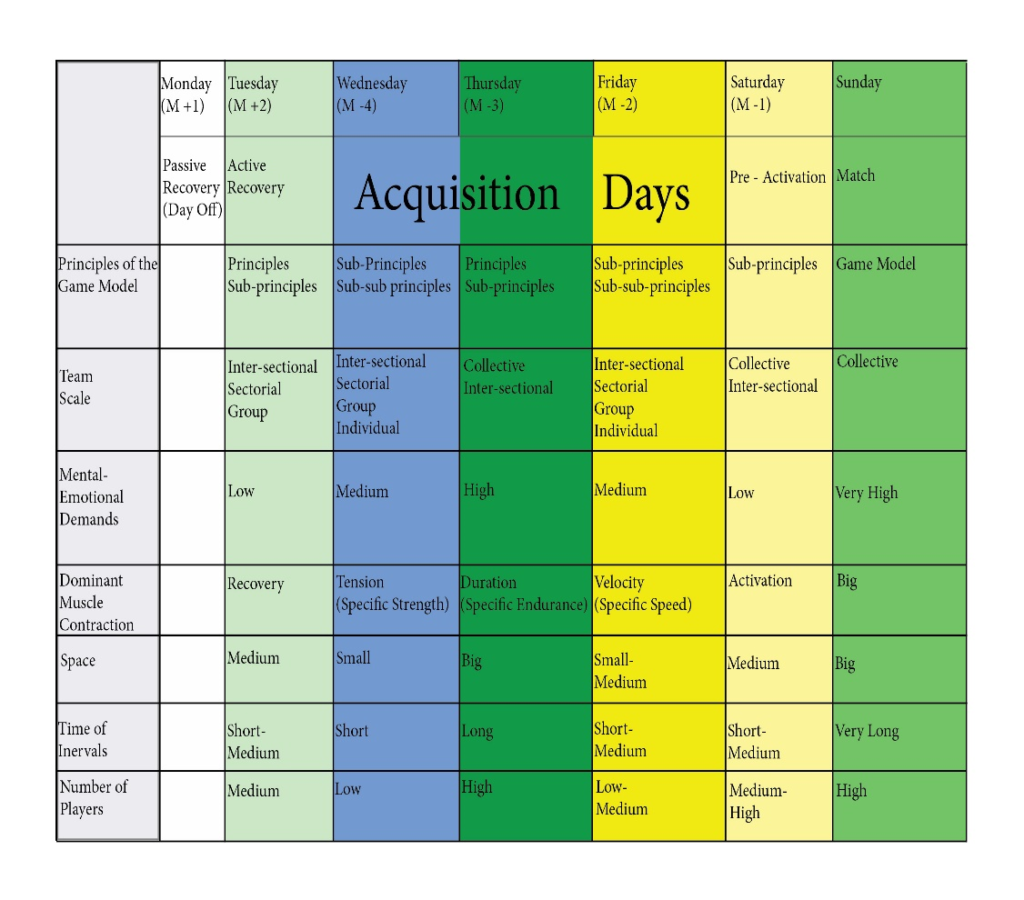
Pre-season in Tactical Periodization
Different to many conventional training methodologies, tactical periodization doesn’t differentiate between pre-season and the rest of the season. Many other methodologies try to achieve high levels of fitness in a short period of time, therefore prioritizing different dimensions of the game in different parts of the season. However, as mentioned earlier in Tactical Periodization the tactical dimension is always the primary driving force of training. For this reason, from the start of the pre-season, the team needs to immediately begin learning the Game Model and work on game principles, so they are operational by the start of the competitive period. According to Mouriho, (in Ameiro et al., 2006) only in the first week of pre-season the training consists of some adaptive exercises in order to get the players introduced to the demands of the game. After that first week every morphocycle prioritizes the tactical dimension and the learning of the Game Model. In tactical periodization there are no peak performances because every game in the season is viewed with the same importance and the objective of the coaching staff is to ensure that players are in optimal performance condition in every game and not in some more than others. (Faria in Ameiro et al., 2006).
Understanding of fatigue
In Tactical Periodization, fitness is understood together with the tactical dimension, therefore a team improves its fitness when it can carry out the Game Model in the game with maximum concentration throughout. So, when a player is considered fatigued, this does not necessarily imply to the physical fatigue. Instead it is fatigue of the central nervous system which comes from constantly making decisions in training and games. Mourinho calls this “tactical fatigue” (Mourinho in Ameiro et al., 2006). For example, if you take a player who scores very high in isolated fitness tests and is deemed very fit under the conventional standards of fitness and place them on a new team, without the proper training of the different Game Model, that player will be tactically fatigued during the game. The player won’t be able to solve many different tactical situations of the game in coherence with the team’s principles and therefore will suffer tactical fatigue.
Conclusion
Tactical Periodization is not just a training methodology, it is a way of thinking and understanding the game of football in its logical structure considering its chaotic and complex nature. While there are some absolutes that according to this methodology must be followed like the Game Model and the Methodological Principles, Tactical Periodization allows a lot of room for the “art of coaching”, which is the coach’s unique style on how to make the methodology operational. As Vitor Frade states: “The formal side of the Tactical Periodization is likely to be captured by many people, but it is not there that lies the key. The key lies in the way you make operational the formal side, in the embodiment. This is where the coach, the one who manages has to be important every day. He must be the guy who brings everything that is favorable to the qualitative growth of the process towards a future that we aspire to be, something that makes sense” (Frade in Oliveira R., 2014).
Writing by Ridi Dauti; Editing by Constantin Eckner; Special thanks to Erik Alves.
References
- Amieiro, B., Barreto, R., Oliveira, B., & Resende, N. (2006). Mourinho ¿por qué tantas victorias? MC Sports.
- Bordonau, J. L. D., & Villanueva José Alberto Mendez. (2018). Tactical periodization: a proven successful training model. London: SoccerTutor.com.
- Frade V. in Borges, P. H. (2015). Periodização tática: fundamentos e perspectivas. Entrevista com Dr. Vitor Manuel da Costa Frade. Conexões: Revista Da Faculdade De Educação Física Da UNICAMP, 13(1), 180–204. doi: 10.20396/conex.v13i1.2155.
- Mallo, J. (2015). Complex Football: From Seirul·los structured training to Frades tactical periodisation (1st ed.). Spain: Topprosoccer S.L.
- Oliveira G. in Farias, F. (2016). Periodização Tática – José Guilherme Oliveira – CBF. Retrieved May 3, 2020, from https://pt.slideshare.net/proffernandofarias/periodizao-ttica-jos-guilherme-oliveira-cbf
- Oliveira, R. (2014). Tactical Periodization: The Secrets Of Soccer Most Effective Training Methodology.
- Tamarit, X. (2015). What is tactical periodization? Oakamoor, England: Bennion Kearney.
4 Kommentare Alle anzeigen
ZH December 29, 2024 um 4:11 am
4 years later and still one of the best resources I keep coming back to
Belayneh Chekle June 8, 2023 um 9:24 am
It too clear by far and simplifying the complex concepts and organizations to the highest.
Fatlum July 12, 2021 um 5:24 pm
Thank you for this article.
It’s very helpful and understanding.
Satr June 20, 2020 um 6:28 am
Thankyou so very much !